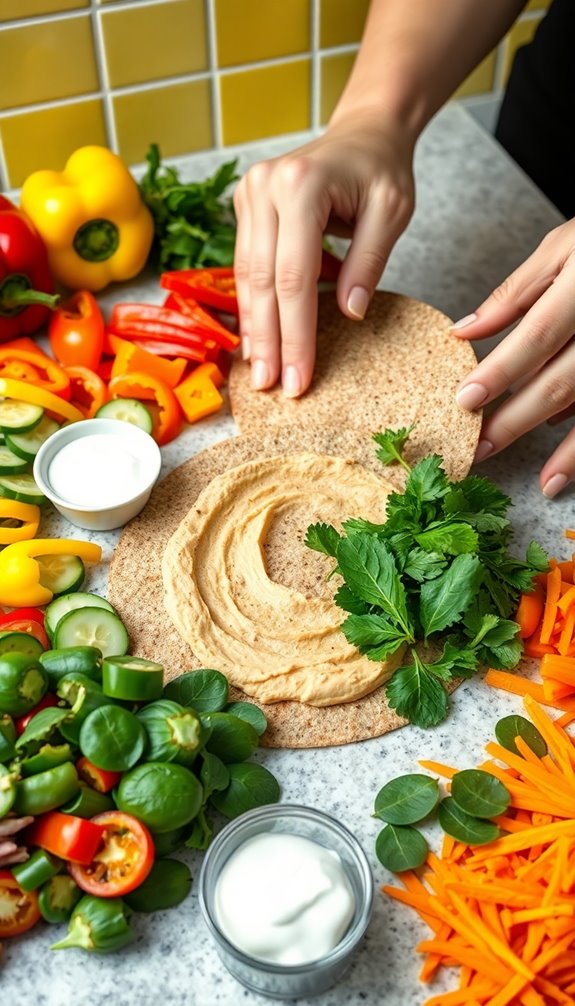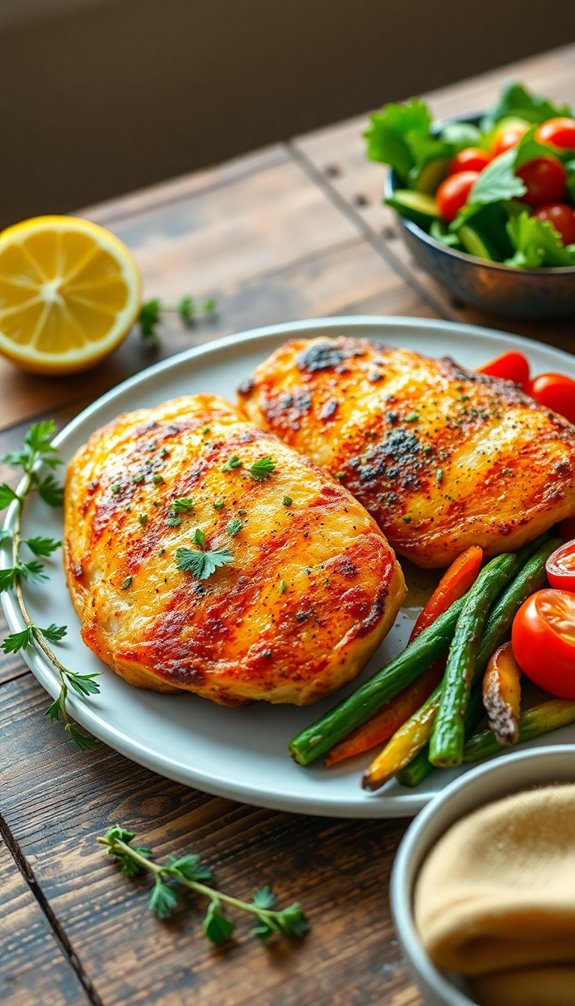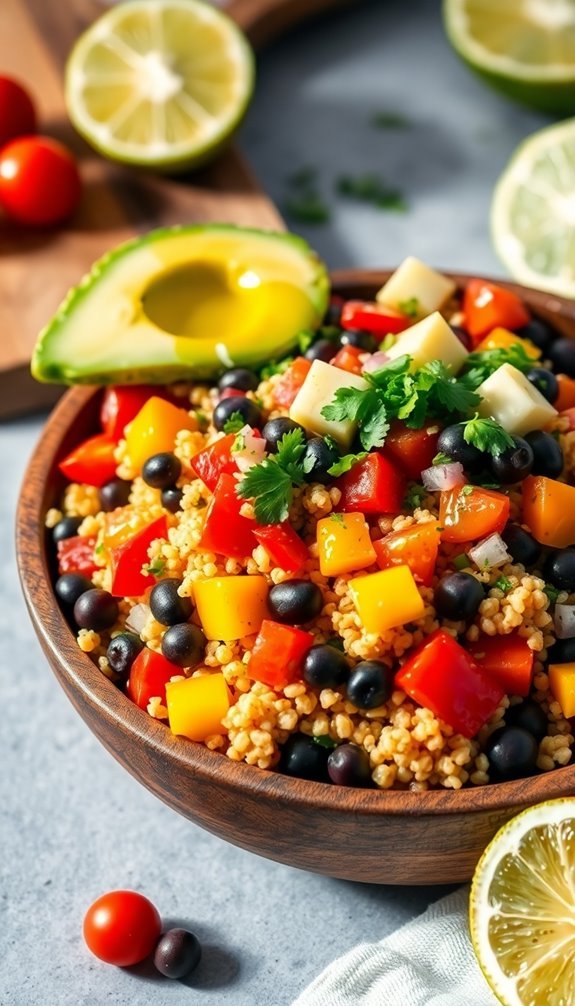Packing a nutritious lunch for school is essential for maintaining energy and focus throughout the day. A colorful wrap can be an excellent choice, combining whole grains with lean proteins and fresh vegetables. This meal not only satisfies hunger but also provides necessary vitamins and minerals. Want to know how to assemble the perfect wrap and make it ahead of time? Let's explore the details.
Recipe Tips and Tricks
- Whole grain tortillas or large lettuce leaves can serve as nutritious wraps filled with protein-rich deli meats and fresh vegetables.
- Spread hummus or cream cheese for added flavor and creaminess while enhancing the meal's nutritional value.
- Include a variety of colorful vegetables like bell peppers and spinach to boost vitamins and minerals in the lunch.
- Prepare wraps the night before to save time and ensure a quick, healthy lunch option for school.
- Encourage kids to customize their wraps with different spreads and fillings for an exciting and balanced meal experience.
How To Make It – Recipe

Making a delicious and nutritious lunch for school doesn't have to be time-consuming or complicated. A great option is a colorful wrap filled with fresh veggies, protein, and a tasty spread. This wrap isn't only easy to prepare but also portable, making it perfect for lunchboxes. It can be customized based on your preferences and what's available in your pantry, ensuring that your child gets a balanced meal that they'll enjoy. Additionally, wraps are a fun way to incorporate delicious lunch ideas that kids will absolutely enjoy into their meals.
To start, gather your favorite ingredients to fill the wrap. You can use whole grain tortillas or lettuce leaves for a low-carb option. The wrap can be filled with deli meats, grilled chicken, or even hummus for a vegetarian alternative. Adding a variety of vegetables like bell peppers, cucumbers, and spinach not only enhances the flavor but also adds essential nutrients. This lunch is sure to be a hit!
Ingredients
- Whole grain tortillas or large lettuce leaves
- Deli meats (turkey, ham, or chicken)
- Grilled chicken strips (optional)
- Hummus or cream cheese
- Sliced bell peppers
- Sliced cucumbers
- Fresh spinach or mixed greens
- Shredded carrots
- Ranch dressing or vinaigrette (optional)
Cooking Instructions
Begin by spreading a generous layer of hummus or cream cheese evenly over the tortilla.
Layer your choice of deli meats or grilled chicken strips on one side of the wrap, followed by a colorful assortment of sliced bell peppers, cucumbers, spinach, and shredded carrots.
Drizzle with ranch dressing or vinaigrette if desired.
Carefully roll the wrap tightly from the side with the fillings towards the other end, ensuring all ingredients are enclosed.
Slice the wrap in half and securely wrap it in foil or parchment paper for easy transport.
Extra Tips
When preparing wraps for school, consider making them the night before to save time in the morning.
Wraps can be stored in the refrigerator and will stay fresh until lunchtime.
To prevent sogginess, avoid adding wet ingredients like tomatoes or overly juicy pickles, or pack them separately.
Feel free to experiment with different spreads and fillings to keep the lunch exciting and varied throughout the week!
Cooking Steps
To get started on your lunch recipe, gather all your ingredients together for easy access.
Next, chop the vegetables into bite-sized pieces, ensuring they're manageable for packing.
Finally, mix in your chosen protein source, add dressing or seasoning, and pack everything in portion containers for a ready-to-go meal. Including healthy protein options will enhance the nutritional value of your lunch.
Step 1. Gather All Ingredients Together
Gathering all your ingredients together is essential for a smooth cooking experience.
Start your meal prep by checking your recipe and ensuring you have everything on hand. This includes proteins, vegetables, grains, and seasonings.
Organize your ingredients in one place; it'll save you time and reduce stress.
With everything ready, you'll be set to create a nutritious lunch for school!
Step 2. Chop Vegetables Into Bite-Sized Pieces
Once you've assembled all your ingredients, it's time to focus on chopping the vegetables into bite-sized pieces. This makes them easier to eat and digest, maximizing their vegetable benefits.
Use proper chopping techniques, like the claw grip for safety, to guarantee uniform sizes. Consistent pieces will cook evenly and enhance the overall flavor and texture of your nutritious lunch.
Step 3. Mix in Protein Source
Incorporating a protein source into your lunch not only boosts its nutritional value but also helps keep you full throughout the day.
Choose from various protein varieties like grilled chicken, tofu, or beans to enhance your meal balance.
Mixing in these proteins not only adds flavor but also guarantees you're getting essential nutrients needed for energy and focus in school.
Step 4. Add Dressing or Seasoning
After you've selected your protein source, it's time to elevate your lunch with the right dressing or seasoning.
Consider dressing variations like balsamic vinaigrette or yogurt-based dressings to add flavor without excess calories.
For a punch of taste, explore seasoning alternatives such as garlic powder, paprika, or fresh herbs.
These enhancements not only boost taste but also increase nutritional value.
Enjoy experimenting!
Step 5. Pack in Portion Containers
To make certain your school lunch stays fresh and organized, it's essential to pack it in portion containers that suit your meal choices.
Using these containers helps with portion control, ensuring you eat the right amounts without overeating.
When meal prepping, select containers that are easy to open and close, making lunchtime hassle-free.
This way, you can enjoy a nutritious meal every day.
Substitution Suggestions
When you're looking to make school lunches healthier or cater to dietary restrictions, choosing the right substitutions can make a significant difference.
Consider healthy swaps like whole grain bread instead of white, or Greek yogurt instead of sour cream.
For ingredient alternatives, use avocado in place of mayonnaise or spiralized veggies instead of pasta.
These changes enhance nutrition without sacrificing flavor. Additionally, incorporating nutritious ingredients like fresh fruits and vegetables can further boost the healthiness of lunch options.
Serving Suggestions
Serving school lunches in an appealing way can make a big difference in your child's enjoyment and willingness to eat.
Focus on lunchbox presentations by using colorful containers and fun shapes. Incorporate creative pairings, like pairing whole-grain wraps with fresh fruit or veggie sticks. This not only boosts nutrition but also keeps lunchtime exciting, encouraging your child to try new foods. Additionally, balanced meal options ensure that your child receives the necessary nutrients for their growth and energy throughout the day.
Make-Ahead and Storage
Preparing lunches in advance can save you time during hectic mornings and assure your child has nutritious meals ready to go. For effective meal prep, assemble lunches on Sundays or the night before school. Store them in airtight containers to maintain freshness. Always keep perishable items refrigerated to guarantee food safety, preventing spoilage and harmful bacteria growth. This approach simplifies your weekday routine considerably. Additionally, incorporating easy meal prep ideas into your routine can make lunchtime even more enjoyable and varied for your child.
Nutrition Facts(per serving)
Understanding the nutrition facts of each lunch you prepare can help secure your child gets a balanced meal. Pay attention to serving sizes to confirm your child receives the essential nutrients they need. A nutritious lunch typically includes proteins, healthy fats, and whole grains, all of which provide significant nutrition benefits. This balance supports their growth, energy levels, and overall well-being throughout the school day. Incorporating high protein options into their lunch can further enhance their nutritional intake.
Final Thoughts
As you consider the meals you pack for your child's school lunch, remember that a well-balanced diet plays a critical role in their development and daily performance. Prioritizing healthy eating not only fuels their bodies but also supports cognitive function. Incorporating delicious vegan options into their lunches can further enhance their nutrition and keep lunchtime exciting.
Recipe FAQs
Can I Use Frozen Vegetables in This Recipe?
You can definitely use frozen vegetables in this recipe. They pack a nutritional punch and save time. Just adjust your cooking time slightly, and you'll be cooking up a storm in no time!
What Kitchen Tools Do I Need for This Recipe?
For this recipe, you'll need essential kitchen tools like a sharp knife, cutting board, and mixing bowl. Cooking gadgets such as a steamer or microwave can also simplify the process, making meal prep easier and efficient.
How Can I Make This Recipe Gluten-Free?
To create a gluten-free masterpiece, swap traditional grains for gluten-free grains like quinoa or brown rice. Use alternative flours such as almond or coconut to enhance flavor and texture, ensuring everyone enjoys your delicious creation.
Are There Any Common Allergens in This Recipe?
Yes, there can be common allergens like nuts. If you're concerned about nut allergies, consider ingredient substitutions such as seeds or dairy-free alternatives to guarantee the recipe remains safe and nutritious for everyone involved.
Can This Recipe Be Made Vegetarian?
Sure, you can totally make this recipe vegetarian! Just swap out meat for vegetable substitutes like tofu or legumes. You'll still get those protein options, ensuring it's nutritious while keeping your taste buds happy!







